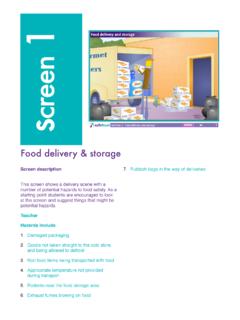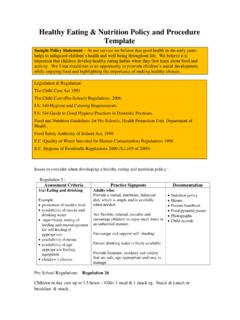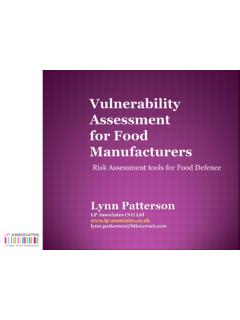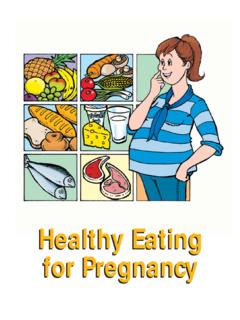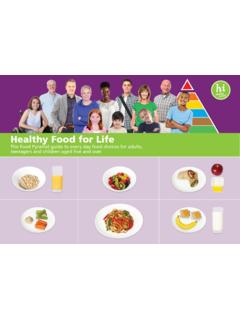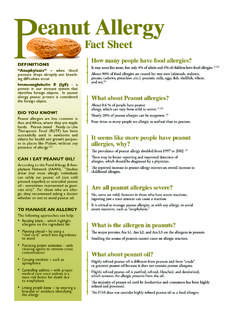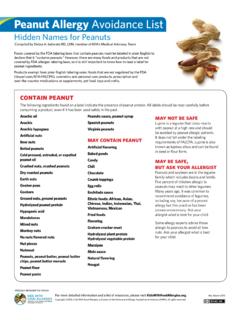Transcription of Food Allergy Intolerance Guidance for the Catering Industry
1 food Allergy & Intolerance Guidance for the Catering Industry This booklet has been produced as part of the all island food Safety Training Programme on food Allergen Control which is sponsored by safefood Acknowledgements This food Allergy resource was produced by safefood in association with Dr. Ian Leitch, Chartered Environmental Health Practitioner with Omagh District Council, Northern Ireland. The participation, support and Guidance of Mr. Martin Devine, Mr. Barney Heywood and the officers of the Environmental Health Services in the Republic of Ireland and Northern Ireland are duly acknowledged and greatly appreciated. safefood also recognises the input and participation of third level Catering lecturers throughout the island of Ireland. Disclaimer: This Guidance is provided in good faith and outlines the general principles of good food allergen management.
2 Safefood disclaims any responsibility for any adverse effects resulting from following the information in this publication. safefood does not give any guarantee that following the advice in this publication will prevent an allergic reaction from occurring. The food business should ensure that it complies in full with the legislative requirements for the manufacture, preparation and sale of safe food . Sole responsibility for the safety of supplied food rests with the proprietor. food Allergy & Intolerance in the Catering Industry In these islands it is estimated that approximately 10 percent of the population suffer from a food Allergy or a food Intolerance (including coeliac condition), the effects of which range from mild discomfort to life threatening. This booklet and accompanying poster are designed as an educational resource for caterers and serve as a practical guideline for serving customers who may have a food Allergy , a food Intolerance , coeliac condition or who may wish to avoid a particular food for other reasons.
3 Since all Catering staff must receive induction training before they start work for the first time and at regular intervals thereafter, the booklet should be used as part of this training to increase Catering staff knowledge and awareness of this issue. The poster is designed as a quick reference source for staff who need to serve an allergic customer or a customer who wants to avoid a food or food ingredient for any other reason. In this context, the booklet and poster will help food businesses meet their legal obligations. It is recommended that a copy of this booklet should be placed in the food safety management file. Please place a copy of the poster at strategic locations such as counter/servery areas, and make all staff members aware of this information and its location. Contents Foreword Disclaimer Contents Introduction 1.
4 Definition 2. Causes 3. Symptoms 3. Avoidance and Treatment 4. Impact on quality of Life 4. Foods that can trigger an allergic reaction 5. Identification of major allergens 6. May contain statements 13. Communication with the customer 14. food allergens, the Law and food Safety Management Systems 15. Due Diligence 15. Best practice food allergen management 17. Nominating an Expert 18. Tact and Diplomacy 18. Ingredients 18. Cross contamination 19. food safety management system 20. Preparing an allergen-free meal 21. Service: Points to remember 21. If the worst does happen 22. Procedure for dealing with a query from your customer 23. 1. Introduction Since the 1950s, the incidence of allergies in developed countries has shown a steady rise. This is particularly noticeable where food Allergy is concerned. For example, peanut Allergy the most common food Allergy to cause fatal or near fatal reactions has trebled in the last twelve years affecting almost 2% of children at school entry level.
5 In Ireland, it is estimated that up to 3% of the population have a food Allergy . Approximately 5% of the adult population are lactose intolerant while approximately 1% have coeliac condition. EU legislation now recognises 14 foods as being responsible for the majority of allergic reactions in Europe. In Ireland, the primary causes of allergic and intolerant reactions to food are peanuts, fish, eggs, tree nuts & seeds, fruits & vegetables, milk and wheat. If you work in the food Industry , particularly in the Catering sector, you need to know how you can control food allergens on your premises. This can be a matter of life or death. 1. Introduction food Allergy & Intolerance Definition .. peanut Allergy the most A food Allergy is an abnormal, exaggerated common food Allergy to cause reaction (hypersensitivity) of the immune system to certain proteins in food .
6 These fatal or near fatal reactions has proteins are known as allergens'. A food trebled in the last twelve Intolerance is also an adverse reaction to a protein or non-protein constituent of a food . However, the immune system is not involved. Examples include lactose Intolerance due to the absence of the enzyme lactase and migraine induced by red wine. Therefore, while the use of the term allergens' to describe the causative agents that can trigger an allergic or intolerant reaction is not technically true, it is frequently used as a collective term in the literature and is used in this context in this document as well. 2. 1. an Allergy to peanut is the most or families that have these conditions, seem to be more prone to developing allergies in common food Allergy to cause general. Most food Allergy fatalities have fatal or near fatal reactions occurred in people with asthma.
7 The prevalence of food allergies and intolerances, including coeliac condition, seems to vary Gluten Intolerance also called coeliac disease between different populations and regions is an auto immune disease where the indicating a strong genetic influence. immune system attacks its own tissues. However, it is not an Allergy . The reaction is Symptoms triggered by gluten which causes the lining of The most common symptoms of an allergic the gut to become damaged. The manufacture reaction may include any combination of the of totally gluten-free food is difficult. following:- Consequently, many foods currently on the Coughing market that address this particular nutritional Dry itchy throat and tongue requirement, although labelled gluten-free , Wheezing and breathlessness may actually contain low residual amounts of Runny nose gluten.
8 A higher standard for gluten-free foods Itchy eyes has recently been introduced but it will exist Flushing of the skin beside the original 1988 standard until 1st Nettle rash (hives) anywhere on the body January 2012. Under the original standard, Swelling of lips and throat gluten-free foods must have less than 200 Changes in heart rate mg/kg (ppm) gluten. Foods manufactured Feeling bloated under the 2009 standard can be called (1) Abdominal pain, nausea and vomiting gluten-free' if they have less that 20 mg/kg gluten or (2) very low gluten' if they have less People with severe allergies can take a reaction that 100 mg/kg gluten. From 1st January 2012 which can be life threatening. This reaction is only the new standard is permitted. called anaphylaxis or anaphylactic shock . which is characterised by:- Causes a sense of impending doom It is not clear why someone develops an a dramatic fall in blood pressure Allergy or Intolerance to food .
9 People with (hypotension). conditions like asthma, eczema or hay fever, a swelling in the throat and mouth 3. Introduction food Allergy & Intolerance chest tightness, breathlessness from place either by the patient's use of severe asthma antihistamines or, if the reaction is severe, collapse and unconsciousness by self medication with an adrenaline (epinephrine) auto-injector followed by Sometimes it is difficult to know if a slight hospital admission. Autoinjectors are reaction like a rash will proceed to the more marketed under the Epipen and Anapen serious anaphylactic shock but urgent medical brands. A food intolerant reaction usually treatment is advised if the customer has resolves with time once the offending food difficulty in swallowing or breathing or if there is removed from the diet. is sudden weakness. Avoidance is the key to controlling food Allergy food Allergy is the most common cause of and Intolerance and those at risk must avoid anaphylactic shock outside the hospital contact with the foods to which they are setting and an Allergy to peanut is the most allergic/intolerant in any form.
10 Common food Allergy to cause fatal or near fatal reactions. Impact on quality of Life The diagnosis of a food Allergy or Intolerance food intolerant reactions tend to be less is very stressful for the person and their severe than those experienced during an immediate family. Many life style changes allergic reaction. Symptoms are usually have to be made, all to ensure that the gastrointestinal, including nausea and patient's health is protected. What to eat, diarrhoea, but can also include those more where to eat, how to cope at parties or at a usually associated with a food Allergy such as new school or when going to college these flushing, headache, hives or wheezing. Unlike are all considerations that take on a a food allergic reaction where symptoms begin heightened importance when a family to manifest immediately, the symptoms of a member has a food Allergy or Intolerance , food intolerant reaction usually take time to especially if the Allergy is life-threatening.
